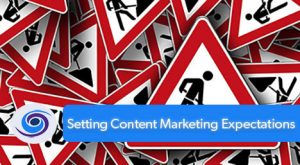Setting content marketing expectations is essential. Not all content is created equally, and not all content serves the same purpose. If you try to use one-size-fits-all (audiences) content marketing approach, you are sure to fail. It’s easier to set and measure goals when you set expectations.

The best way to illustrate our point is to outline what we expect with our content marketing for Trinity Web Media, and then you can see real-world examples.
Written Content / Blog Posts
The Trinity Web Media Digital Marketing Blog is a vehicle we use to help answer our client’s questions and make our company more visible. Whenever I speak at WordPress Conferences like WordCamp New York City, I always make sure to talk about how we believe in writing from your audience and not for search engines. If you answer questions, your audience has, inherently you will perform better in search, provided your answer and content is excellent.
Use the written word for:
• Answering Questions / Being Helpful
• Subject Matter Expertise Positioning
• Search Positioning
Video Marketing
For close to two years now, I have created and posted two videos a week for our Trinity Web Minute Video Series. This content is then posted to YouTube, IGTV, our blog, and re-purposed as Bonus episodes of our podcast, The New Marketing Show. (Really, one video is leveraged into 5 or 6 posts across all our broadcast channels.)
Video is an easy way to deliver your message with passion, expertise, and personality. Whenever possible, during or after client meetings, we direct a client to our video series to get more information. This is an easy way to keep the context of your message intact as your brand spreads client to client.
Uses of video content:
• Multi-platform posting
• Business Development
• Subject Matter Expertise Positioning
• Search Positioning
Social Media
Yes, social media plays a part in your content strategy. Social media is probably the most used, yet least understood content marketing platforms. All to often, everyone gets caught up on vanity metrics and ignore the metrics that move the needle for your business.
Jay Baer always used to say, “The idea of social media is not to do social, but to be social.” That means that every time we publish something on Facebook, Instagram, or Twitter, the idea is to interact and engage after the post. Interact and engage does not mean sell.
Trinity uses our social media platforms as a way to talk about what we are up to, what problems we are solving, and how we play a more significant part of the business landscape. Social is also a great way to display brand culture and personality.
Uses of social media:
• Branding
• Engagement
Podcasts
Since January 2018, we have produced The New Marketing Show. This podcast is not just another marketing/WordPress podcast. We highlight how effective digital marketing and WordPress Development solve business problems. Our podcast is the most time-consuming piece of Trinity Web Media’s content marketing strategy but is the most valuable.
No, we do not get 1000 downloads a show. No, we do not have the show monetized. We use our show as our number one business development tool. It’s great when we are in a meeting and says, “We discussed your very problem on Episode 32 of our podcast.”
This positions Trinity Web Media as experts on topics that revolve around marketing, social media, and web design.
How we use podcasts:
• Branding
• Engagement
• Subject Matter Expertise
• Positioning
• FAQ Repo
We are fortunate to have these platforms all available to our business. There is no way one works as intended without the other pieces playing their parts. There is no reason you cannot follow suit and put the same plan in place. Use all media available and figure out how they work together, and I bet you will see a difference on all accounts.


 While I’ve known Greg for years from our time together in the marketing scene, I’ve only recently had the chance to work with Trinity Web Media on a client project. Not only was the team professional and their work spot on, they were amazingly quick to respond and required very little hand-holding along the way. I chalk that up to their past experience and a deep understanding of best-in-class services.
While I’ve known Greg for years from our time together in the marketing scene, I’ve only recently had the chance to work with Trinity Web Media on a client project. Not only was the team professional and their work spot on, they were amazingly quick to respond and required very little hand-holding along the way. I chalk that up to their past experience and a deep understanding of best-in-class services. I have hired Greg and the Trinity team multiple times for work on my own websites, and have also hired them to work on behalf of multiple clients. He is simply a pleasure to work with, in every respect. Smart but without the giant ego of some developers, Trinity Web Media works with his clients to achieve their vision in the best way possible — with careful attention to their interests, and thoughtful recommendations based on his expertise. • Susan Baier – Founding Marketing Strategist – Audience Audit
I have hired Greg and the Trinity team multiple times for work on my own websites, and have also hired them to work on behalf of multiple clients. He is simply a pleasure to work with, in every respect. Smart but without the giant ego of some developers, Trinity Web Media works with his clients to achieve their vision in the best way possible — with careful attention to their interests, and thoughtful recommendations based on his expertise. • Susan Baier – Founding Marketing Strategist – Audience Audit